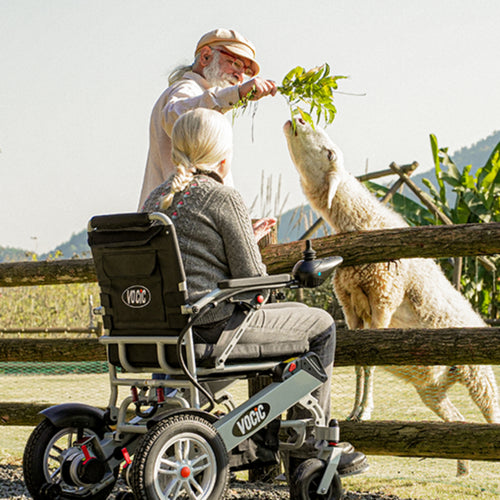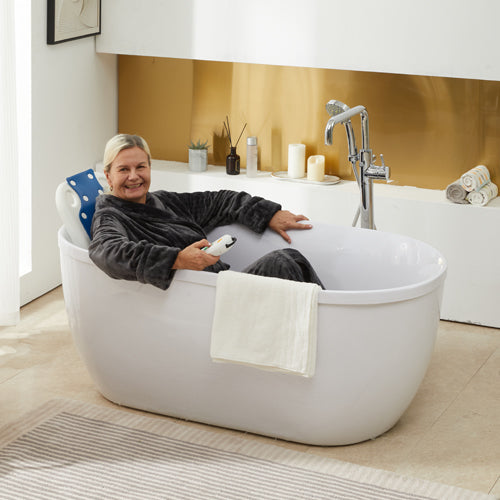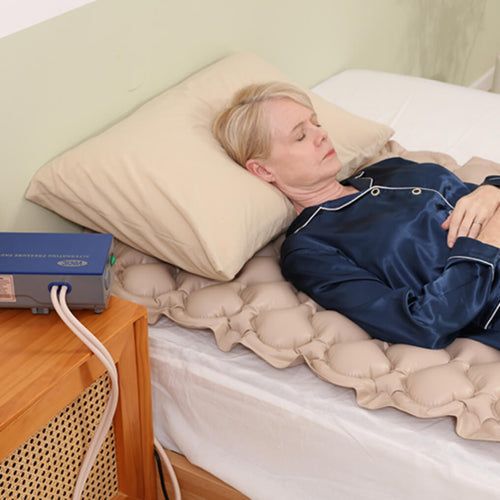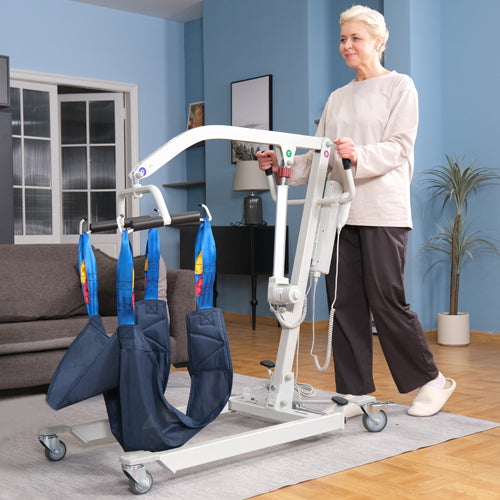Bathing keeps older adults healthy and hygienic. It helps remove dirt, sweat, and bacteria from the skin, reducing the risk of infections, skin, and other problems. Bathing also prevents the body from developing odors and promotes a sense of cleanliness and freshness.
This article talks about how to help seniors bathe, as well as prevent other infections and health problems that are common in older adults.
Safety Measures to Safeguard Elderly Bathing
Ensuring a safe and comfortable bathing environment can ensure the health and confidence of seniors during their bathing routine. By taking appropriate safety measures, adapting the environment to the specific needs of older adults, and introducing assistive devices and products, caregivers can improve the bathing experience for older adults.
1. Preventing Falls with Adequate Safety Measures
Preventing falls is a top priority when providing care for older adults in the bathroom. Caregivers should install grab bars near the shower or bathtub to provide support and stability as seniors enter and exit these spaces. Non-slip mats on the floor of the shower or tub can also reduce the risk of slips and falls. In addition, ensuring that all areas are well-lit, especially where there is a risk of slipping, can prevent the risk of falls.
2. Adjusting the Environment to Suit Seniors' Needs
Adapting the bathroom environment to meet the needs of older adults includes making thoughtful adjustments to accommodate their comfort and convenience. This includes setting the water heater at the proper temperature to prevent scalding or discomfort in the shower. Installing lever faucets instead of knobs can make it easier for seniors with limited dexterity to control the flow of water.
3. Introducing Assistive Devices and Products
With the option of going for shower chair assistive device products, shower chairs can enhance the bathing experience for seniors while increasing their independence. Shower chairs or benches can provide stability for those who have difficulty standing for long periods. Handheld showerheads provide flexibility in directing the flow of water, allowing seniors to have more control over their bathing routine.

Why Shower Chairs Can Help the Elderly?
The Shower Chair provides safety and independence in the shower for those with limited mobility. Featuring rubberized feet, waterproof construction, and optional arm/backrests, it reduces fall risks and enables autonomous bathing, enhancing overall comfort.
Shower chair for elderly offer a lot of help, mainly by increasing their safety and independence in the bathroom. Here are a few reasons why shower chairs are helpful for seniors:
- Enhanced safety: Elderly people are prone to slipping or falling in the bathroom due to the deterioration of their body functions. Shower chairs provide a stable point of support on which to sit while bathing, greatly reducing the risk of falls.
- Provide comfort: For seniors with joint pain or difficulty standing, the shower chair provides a comfortable seated bathing option, reducing their discomfort and fatigue when standing.
- Maintain independence: Using a shower chair can help older adults complete the daily activity of bathing more independently and reduce dependence on others, thereby improving quality of life and self-esteem.
- Adaptable: Shower chairs are often height-adjustable to accommodate seniors of different heights and sizes, and some models come with armrests and backrests for extra support.
- Easy to use: Shower chairs are designed with the physical conditions of the elderly in mind, usually using non-slip materials, simple to install, and easy to use in the bathroom.
Steps for Using a Shower Chair
Shower chairs can help older people or those with limited mobility bathe with ease. Proper use of a shower chair increases safety, and shower chairs can be adjusted to suit individual needs and health conditions. The following are general steps for using a shower chair:
- Preparation: Make sure the shower chair is securely placed in the shower stall and shows no signs of looseness or movement. Make sure the shower head can easily adjust the water flow and temperature.
- Sit down: Sit down on a shower chair and make sure you feel comfortable and stable. Adjust the height of the chair as needed so that your feet can easily reach the floor.
- Turn on the faucet: Adjust the shower head to make sure the water is at the right temperature, then turn on the faucet.
- Bathing: Use a handheld shower head or a fixed shower head to bathe the body. You can adjust the angle of the shower head as needed to ensure the water reaches the areas you need to clean.
- Cleanse: Use cleansing products such as shampoo and body wash to clean your hair and body. You can use a sponge or bath mitt to assist with cleaning.
- Rinse: Use a shower head to rinse cleansing products from your body and hair.
- Turn off the faucet: When you're done bathing, turn off the faucet and make sure there are no drips in the shower.
- Getting out of the shower chair: When you feel ready to get out of the shower chair, carefully stand up and make sure you feel stable and balanced. Before standing, you can shift your weight to the edge of the chair and use a chair or shower support to help you stand.

How to Choose the Right Shower Chair?
If you are planning to purchase a shower chair for seniors, I have some suggestions for you. When choosing the most suitable shower chair, you need to consider the safety, comfort, and functionality of the shower chair.
1. Assess the user's needs: Consider the user's physical condition and mobility. Those with limited mobility may need a chair with armrests and a high backrest, while others may just need a basic stool.
2. Check for stability: A good shower chair should have a sturdy structure that can hold the user's weight securely without wobbling. Look for chairs with non-slip rubber feet for added safety on wet floors.
3. Material and Durability: Choose shower chairs made from waterproof materials that are easy to clean and rust-resistant, such as aluminum and plastic chairs. This helps ensure longevity and hygiene.
4. Adjustability: If the shower chair is going to be used by more than one person, or if you anticipate that the needs of the users will change over time, then you should choose a shower chair that is height adjustable. This feature allows the chair to be customized for different users and situations.
5. Size and fit: Make sure the shower chair fits comfortably in the shower space without impeding movement. The chair should also be the right size for the user, providing enough seating space without being too bulky.
6. Comfort features: For added comfort, some shower chairs have padded seats and backrests. This is especially beneficial for users with sensitive skin or those who need to sit for long periods.
7. Ease of Maintenance: Chairs should be easy to clean, with smooth surfaces and minimal crevices where mold and bacteria can accumulate.
8. Additional Features: Some chairs offer additional features such as foldability for easy storage, handles for better grip, or wheels for users who need to get in and out of the shower area safely.
It needs to be based on the needs of the user and the practicalities of bathroom layout and use. A healthcare provider or occupational therapist can also be consulted and can provide insights based on individual circumstances.
Conclusion
In the field of geriatric care, compassion and empathy are the cornerstones of effective care. Understanding the unique needs and challenges faced by older adults can provide them with the support and encouragement they need to stay healthy.
FAQ
1. How often should an elderly person bathe?
Older adults should generally bathe at least once or twice a week to maintain hygiene and prevent skin problems. Seniors with special health conditions or incontinence may require frequent bathing. For those with mobility or cognitive impairments, alternatives such as sponge baths or leave-on cleaners may be used. Safety features such as grab bars and shower chairs are recommended to improve safety.
2. Is a bath or shower better for the elderly?
The choice of bathtub or shower for older people depends on their mobility, health, and personal preferences. Bathtubs are therapeutic for conditions such as arthritis, but the safety of entry and exit needs to be considered and are therefore not recommended for people with mobility problems. Showers are more recommended for older people as they have safety features such as grab bars and non-slip mats. In addition, VOCIC has a liftable lift chair that can be lifted and placed for use in the bathtub; this lift chair was designed and developed for this purpose.
3. What are the reasons why old people don't bathe?
Older people may avoid bathing because of health problems such as mobility and sensory sensitivities, as well as privacy and psychological factors. For example, unsafe bathrooms or inadequate bathing facilities cause them to be reluctant to bathe.









